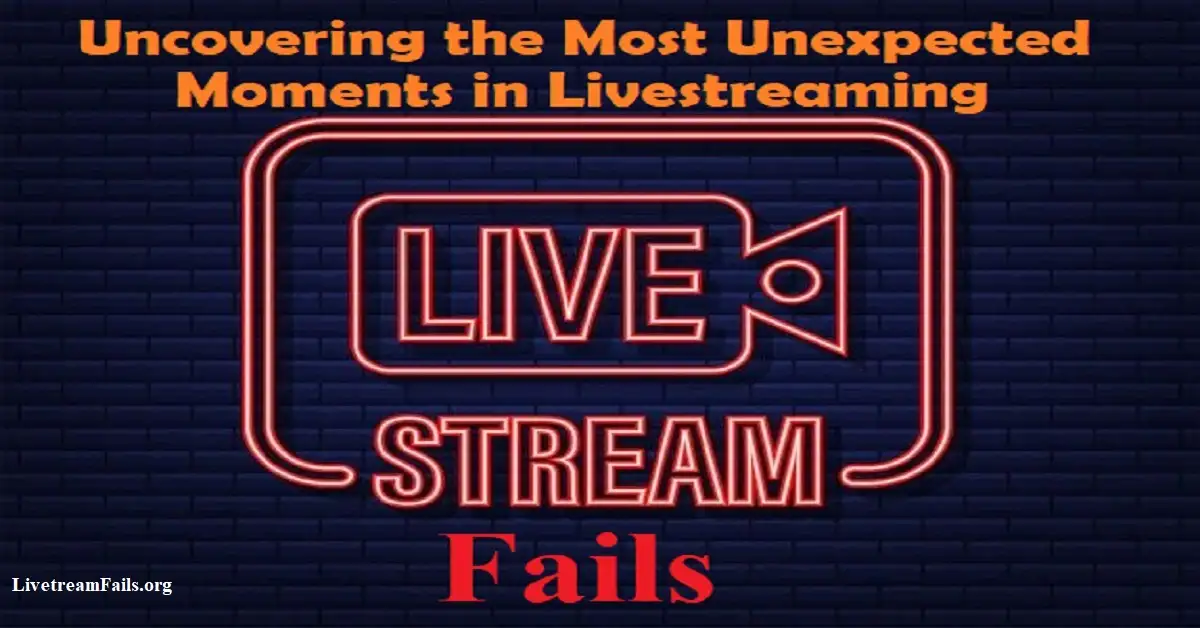Behind the Stream: Uncovering the Most Unexpected Moments in Livestreaming
Table of Contents:
- Overview of LivestreamFail
- Introduction
- The Anatomy of a LivestreamFail
- Why People Watch LivestreamFail
- Impact of Fails on Streamers
- Role of Social Media and Clip-Sharing Platforms
- Viewer Responsibility and Streamer Support
- Conclusion
- FAQs
Overview of LivestreamFail
| Section | Key Points |
|---|---|
| Introduction | – Livestreaming’s popularity on platforms like Twitch, YouTube, Facebook Live. – Exploration of the raw, unedited nature of livestream fails and their appeal. |
| The Anatomy of a LivestreamFail | – Categorization of fails into technical glitches, gameplay blunders, on-camera accidents, unexpected interruptions. – These incidents remind viewers that streamers are real people. |
| Why People Watch LivestreamFail | – Schadenfreude, or joy in others’ misfortunes. – Community bonding and relatability through shared humorous fails. – The thrill of live, unpredictable content. |
| Impact of Fails on Streamers | – Viral moments can boost popularity but also cause mental health challenges. – The community’s reaction can significantly affect the streamer’s experience. – Adaptation and growth from fails. |
| Role of Social Media and Clip-Sharing Platforms | – Amplification of fails beyond original audience. – Issues around monetization and copyright when fails are compiled. – Social media’s role in shaping public perception of streamers. |
| Viewer Responsibility and Streamer Support | – Viewers have a role in creating a positive environment and supporting streamers. – Importance of supportive viewer responses during and after fails. – Building a supportive community culture. |
| Conclusion | – LivestreamFail highlight the unpredictability of streaming. – Importance of embracing the unexpected with humor and empathy. – The impact of livestream fails on digital culture. |
| FAQs | – Advice on viewer responses to fails. – Discussion on whether streamers can prevent fails. – Positive outcomes from fails, such as increased engagement and viewer support. |
Introduction
In the digital age, livestreaming has surged in popularity, becoming a mainstay of entertainment on platforms like Twitch, YouTube, and Facebook Live. These live broadcasts offer a unique glimpse into the unfiltered experiences of streamers, where anything can happen, often leading to unexpected and sometimes hilarious mishaps known as “LivestreamFail.” These moments, whether they be technical mishaps, gameplay errors, or spontaneous interruptions, captivate audiences worldwide, showcasing the human and unpredictable side of streaming. This article delves into the dynamics of livestream fails, exploring why they hold such appeal and how they impact the community of viewers and streamers alike.
The Anatomy of a LivestreamFail
LivestreamFail can range from the mundane to the catastrophic, and they often serve as memorable highlights or notorious lowlights of a streamer’s career. Understanding these fails requires a breakdown of their common types and the conditions that foster them:
- Technical Glitches: Perhaps the most frequent and universally experienced are technical glitches. These include software crashes, buffering issues, poor sound quality, and complete stream disconnections. Often linked to inadequate hardware or unstable internet connections, these technical difficulties can disrupt the flow of a broadcast and lead to viewer frustration.
- Gameplay Blunders: In the world of gaming streams, mistakes during gameplay, such as missing an easy kill, failing a level repeatedly, or misunderstanding game mechanics, often turn into viral moments. These blunders are not only humorous but also humanize the streamer, making them more relatable to viewers who have likely made similar mistakes themselves.
- On-Camera Accidents: Physical mishaps caught on camera are another major category. This could be anything from spilling a drink on a keyboard to more severe accidents like tripping over wires or breaking equipment. These moments are unforeseen and often prompt an immediate, genuine reaction from the streamer, which can be endearing or shocking to the audience.
- Unexpected Interruptions: Real life does not pause for livestreams, leading to interruptions like doorbell rings, children or pets entering the scene, or background noises that catch a streamer off-guard. These breaks in the planned stream content often add a layer of authenticity to the digital persona of a streamer.
The unpredictable nature of these incidents is a key component of their appeal. Streamers can plan content, but they cannot script genuine, unedited reactions and the natural flow of live interaction. These moments break the fourth wall, reminding viewers that streamers are real people in real environments, not merely performers on a digital stage.
Why People Watch LivestreamFail
The allure of LivestreamFail lies in a complex mix of psychology, community culture, and the thrill of live entertainment:
- Schadenfreude: The concept of finding joy in the misfortune of others is a significant reason people are drawn to livestream fails. This psychological phenomenon is amplified in competitive or high-stakes environments like gaming or live performances, where the pressure is palpable and the fail has higher stakes.
- Relatability and Humor: Watching someone else make a mistake can be inherently relatable and comforting. It reminds viewers that everyone, regardless of their online fame or expertise, can falter. The humor in these situations often comes from the unexpected nature of the fail and the streamer’s response, which can range from embarrassment to good-natured humor.
- Community Interaction: Livestream fails often become talking points within communities. Viewers share clips, create memes, and discuss these moments in chat rooms and forums. This interaction enhances the communal experience of streaming, binding viewers together as they react and discuss what happened.
- Vicarious Experience: There is a thrill associated with watching live events unfold in real-time, particularly when something goes wrong. The unpredictability adds an element of suspense that pre-recorded content cannot match. Viewers feel like they are experiencing the moment alongside the streamer, which can be exhilarating and memorable.
- Catharsis: For some, watching fails provides a form of catharsis, especially if they see a streamer recovering gracefully from a mistake. It can be reassuring to see someone handle a blunder with poise, providing a model for viewers on how to deal with their own real-life mishaps.
In essence, the reasons behind watching livestream fails are as multifaceted as the viewers themselves. These moments serve not only as entertainment but also as a means of building and reinforcing community ties, providing humor and relatability, and offering a live, unscripted escape from the polished, predictable content elsewhere on the internet.
Impact of Fails on Streamers
LivestreamFail, while often entertaining for the audience, can have a profound impact on streamers both positively and negatively:
- Viral Attention: A fail that catches the audience’s fancy can unexpectedly turn a streamer into an internet sensation overnight. This surge in popularity can increase viewership and followers substantially, which might translate into higher earnings from ads, subscriptions, and sponsorships.
- Mental Health Challenges: Not all attention is good attention. Streamers, especially those who experience fails that attract negative feedback or mockery, can suffer from anxiety, stress, and self-doubt. The pressure to perform perfectly in subsequent streams can also take a psychological toll, leading to burnout or even a temporary or permanent step back from streaming.
- Community Support and Backlash: The community’s reaction to a fail can greatly influence its impact. Supportive viewers can help a streamer recover from a mishap, offering reassurance and encouragement. Conversely, toxic responses can exacerbate the negative effects of a fail, sometimes leading to hostile environments.
- Adaptation and Growth: Streamers often learn from their fails, adapting their setup or their content to avoid future issues. This learning curve is crucial for professional growth and helps in building a more resilient streaming approach.
Role of Social Media and Clip-Sharing Platforms
The role of social media and clip-sharing platforms in broadcasting livestream fails cannot be understated, as these platforms can amplify a moment’s reach exponentially:
- Amplification of Moments: Platforms like Twitter, TikTok, and Instagram allow viewers to share livestream fails beyond the confines of the original streaming platform. A clip that goes viral can reach millions of viewers worldwide, far exceeding the streamer’s usual audience.
- Monetization and Copyright Issues: Compilation channels on YouTube and other platforms often curate livestream fails into popular videos that can generate significant ad revenue. However, this raises questions about copyright and the ethical implications of profiting from someone else’s potentially embarrassing moment without their explicit consent.
- Influence on Public Perception: How a fail is portrayed on social media can shape public perception of the streamer involved. Editing and context are often manipulated in these clips, which can lead to misunderstandings or a skewed narrative about what actually happened.
Viewer Responsibility and Streamer Support
The relationship between viewers and streamers is symbiotic, and the responsibility of the viewers in this equation is significant:
- Encouraging Positive Interaction: Viewers have a responsibility to foster a positive environment. This involves discouraging toxic behavior among fellow viewers and supporting the streamer through constructive feedback rather than ridicule.
- Support During and After Fails: How viewers react during and after a fail can greatly affect a streamer’s confidence and willingness to continue streaming. Expressing support, understanding, and encouragement can help mitigate the negative impacts of a fail.
- Promoting a Supportive Community Culture: Long-term viewer support involves more than reacting positively to fails. It includes participating in community activities, engaging with content respectfully, and sometimes defending the streamer from undue criticism or harassment.
Each of these areas highlights the interconnected nature of livestreaming, where actions and reactions ripple across the viewer-streamer divide. Understanding the weight of these interactions can help cultivate a healthier, more supportive livestreaming ecosystem.
Conclusion
LivestreamFail illuminate the inherent unpredictability of live broadcasting and humanize the streamers by exposing their imperfections. These spontaneous moments foster a sense of community and relatability, drawing viewers closer to streamers. As the landscape of livestreaming continues to evolve, so too does the nature of these fails and their reception by the digital audience. Embracing the unexpected with humor and empathy not only enhances the viewing experience but also supports a healthier, more engaging online community. Through this exploration, it’s clear that livestream fails are more than just mistakes; they are a vital part of the livestreaming culture.
FAQs
Q: What should a viewer do if they witness a livestream fail?
A: Viewers should maintain respect and empathy, reacting in a way that supports the streamer rather than mocking or belittling them.
Q: Can streamers prevent livestream fails?
A: While some technical issues can be mitigated with proper equipment and preparation, many fails are simply part of the unpredictable nature of live broadcasting.
Q: Are there any positive outcomes from livestream fails?
A: Yes, many streamers have gained larger followings and enhanced viewer engagement from the relatability and entertainment value of fails.
This article encapsulates the phenomenon of LivestreamFail, providing insight into their impact on both viewers and streamers while exploring the broader implications of this unique form of entertainment.





